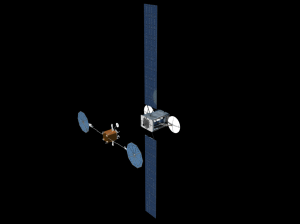NASA SSA Gives Further Momentum to ViviSat’s In-Orbit Servicing Ambitions
[Via Satellite 12-24-2014] NASA has announced collaborative partnerships with four U.S. companies developing new space capabilities for government and commercial customers. The un-funded partnerships with SpaceX, United Launch Alliance (ULA), ATK Space Systems and Final Frontier Design are part of the Collaborations for Commercial Space Capabilities (CCSC) initiative to bring new space technologies to market in five years time.
ViviSat, a joint venture between ATK and U.S. Space focused on in-orbit servicing, stands to benefit significantly from this partnership. Though unfunded, the CCSC initiative provides potential access to technical expertise, assessments, knowledge from lessons learned, technologies and data from NASA.
NASA has cited in-orbit servicing numerous times as an emerging high-potential market for space businesses. In a 2013 interim report titled “Public-Private Partnerships for Space Capability Development,” the agency identified $2.2 billion in lost revenue from satellites in Geostationary Earth Orbit (GEO) due to launches that left them in wrong orbits between 1997 and 2007. According to the report, there were a total of $700 million in insurance claims filed since 2008 from incorrect orbital deployments or fuel leaks. The Office of Strategy Formulation and the Chief Technologist’ s Emerging Space Office also collaborated on the study.
From 1990 to 2010, NASA wrote that 86 satellites had potential for servicing opportunities — 50 for fueling and 36 for repairs. ViviSat’s Mission Extension Vehicle (MEV) can rendezvous and dock with a satellite in GEO and provide station keeping, relocation or de-orbiting services. In June ViviSat COO Bryan McGuirk, told Via Satellite the company was seeing a lot of demand for using MEVs to trial new orbital slots. MEVs can also rescue satellites from improper orbits.
“The [Space Act Agreement] allows ATK and NASA to develop solutions that support NASA’s 2014 Strategic Plan to advance commercial space efforts in use of space logistics and space vehicle transport technologies,” Tom Wilson, vice president and general manager of ATK’s Space Systems division said in a statement.
In October Jim Armor, vice president, ATK Space Systems Division, said the company was planning to launch the first MEVs in three to four years at a rate of two MEVs every 18 months. Speaking at the Hosted Payload and SmallSat Summit, Armor detailed a constellation of 10 or more MEVs. Over time, ViviSat could look to increase its capabilities to include greater satellite servicing, refueling and potentially providing battery power, he said.
MEVs have a design life of 16 years, and can service multiple customers during that time. Each servicing mission would last three to five years. MEVs also have room to support hosted payloads.
NASA’s SAA agreement with ATK outlines principle milestones on ATK’s scheduled commercial activities and gives NASA the ability to offer assistance and feedback. In a 2014 “Public-Private Partnerships for Space Capability Development” report, NASA acknowledged that the technology for in-orbit servicing exists today, but that it must overcome technological and economic challenges.
“Technical challenges include rendezvous, docking, or berthing with a satellite; ensuring a fully sealed connection for propellant transfer; the identification and swap out of components; and autonomous operations. The technologies involved are not new and are not necessarily complex, but their integration into a mission remains the biggest technical hurdle,” the agency wrote in the report.
NASA said it is unclear from a cost perspective how risks would be perceived in a rescue mission. Still, the agency is optimistic that in-orbit servicing can be commercialized, as evidenced by this collaborative agreement.
“Companies in all shapes and sizes are investing their own capital toward innovative commercial space capabilities,” Phil McAlister, director of commercial spaceflight development at NASA said in a statement. “These awards demonstrate the diversity and maturity of the commercial space industry.”
